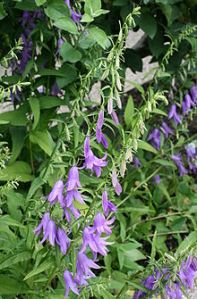
A close relative of The rapunzel plant (Campanula rapunuloides). Photo from Wikipedia.
I never suspected that I’d learn something about edible botany by indulging my 3-year-old’s princess obsession, but I have. According to the Brothers Grimm, Princess Rapunzel is named after the cultivated vegetable of the same name, growing in a witch’s garden. The wording of the story suggested to me that the Grimms’ contemporaries would be familiar with the plant as a vegetable, that it wasn’t a fantastical invented thing. Apparently rapunzel was a popular vegetable in the Grimm’s Europe.
Formally the rapunzel plant is Campanula rapunculus, native from southwestern Asia through central Europe to North Africa. The genus Campanula contains upwards of 500 species of what are commonly called bluebells, bellflowers, or harebells, widely distributed throughout the northern hemisphere. Many if not most of those species have edible flowers, leaves and roots (see links here, here, here and here). The Brothers Grimm don’t specify which parts of the plant were particularly enticing to Princess Rapunzel’s mother.

Our princess, in the Tangled-inspired dress from Santa
Many species in the closesly-related genus Adenophora also have edible roots, leaves and flowers. These genera add a taxonomic family, Campanulaceae, to our list of taxa with culinary species. Campanulaceae joins the sunflower family (Asteraceae) as culinary families in the order Asterales. Rapunzel seeds are for sale, and it can grow in Anchorage, where we will be moving this spring. My little Rapunzel will have to beat the moose to it in the garden next summer. It’s so interesting to me that this was once considered a common, mainstream cultivated vegetable, but now it’s considered a fringe edible plant or something to be “wildharvested.” It’s fun to learn about plants that were once widely cultivated for food but have since fallen out of fashion. Wonder why that is.
It looks to me like your central photo is C. rapunuloides rather than C. rapunculus. I will caution that C. rapunculoides is extremely invasive and is one of my worst enemies here in west-central Minnesota as I try to restore my yard to a native landscape. I’m not sure about the edibility of C. rapunculoides, or the invasiveness of C. rapunculus, but I would be wary of intentionally introducing either of them into a North American landscape.
LikeLike
I’m at Wikipedia’s mercy for the photo, but you may very well be right. C. rapunculoides appears to be edible (see here and here). Thanks for the caution about Campanula invasiveness. Perhaps testing it out in a planter box will be the way to go.
LikeLike
Enjoyed this read. Love the picture of our princess.
LikeLike
Thanks!
LikeLike
Confusion abounds regarding the common names (which is why we hate them so much) rapunzel and rampion, which may the the same thing or two similar species, or a succulent euphorb (Sarcostemma). Clearly the fairy tale doesn’t involve the latter. What fun!
LikeLike
Thanks for mentioning the common name synonym rampion.
LikeLike
I had forgotten that part of the story until you mentioned it. Best of luck on your adventures in Alaska! I always enjoy reading the blog as does my neighbor!
LikeLike
Thanks, Sharifa, for reading and sharing the blog with your neighbor. We’re very excited about Alaska. Yeah, I had forgotten about the Rapunzel = plant detail until we read a recent translation of the Grimm story. They wrote about it in a way that suggested to me that their readers would be familiar with the plant as a vegetable, that it wasn’t an invented thing. Apparently rapunzel was a popular vegetable in the Grimm’s Europe. It’s fun to learn about plants that were once widely cultivated for food but have since fallen out of fashion. Wonder why that is.
LikeLike
Pingback: Spruce tips | The Botanist in the Kitchen